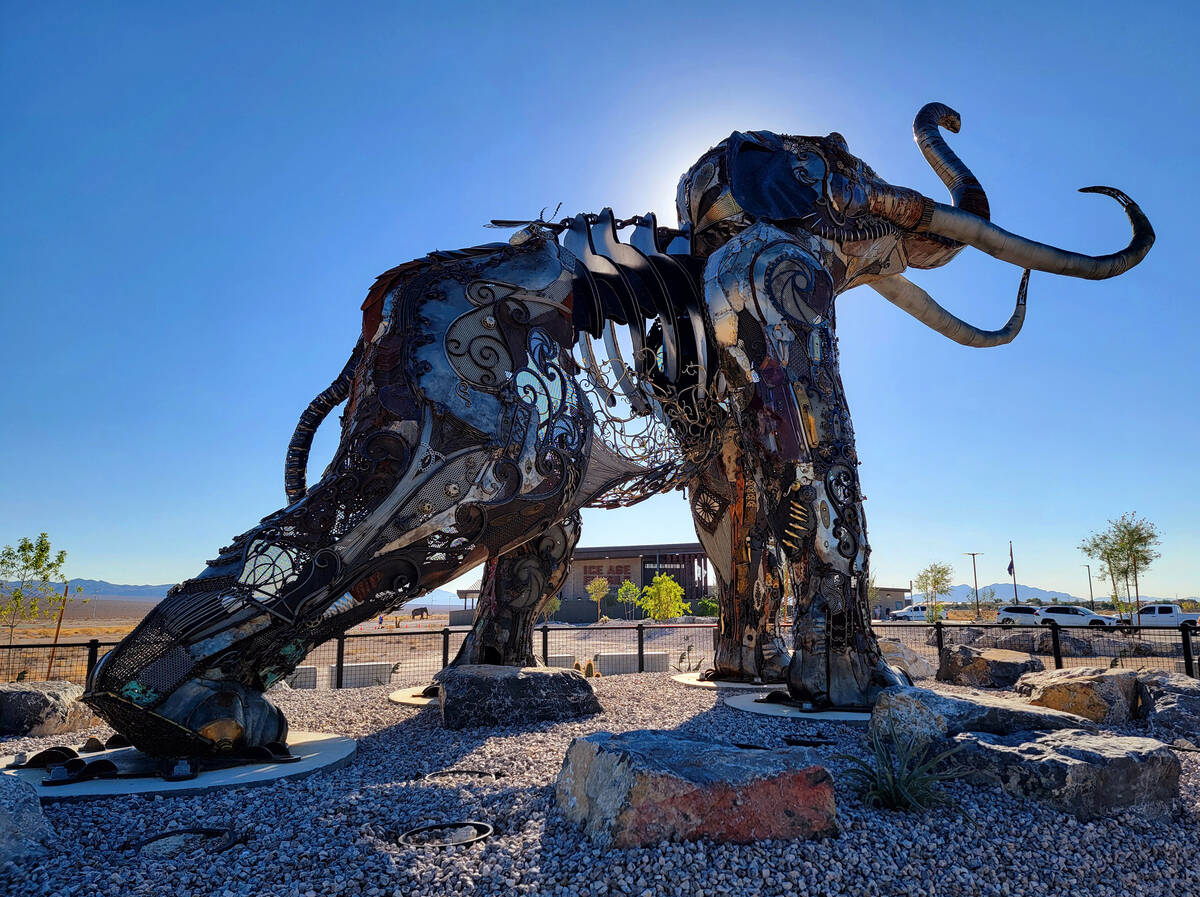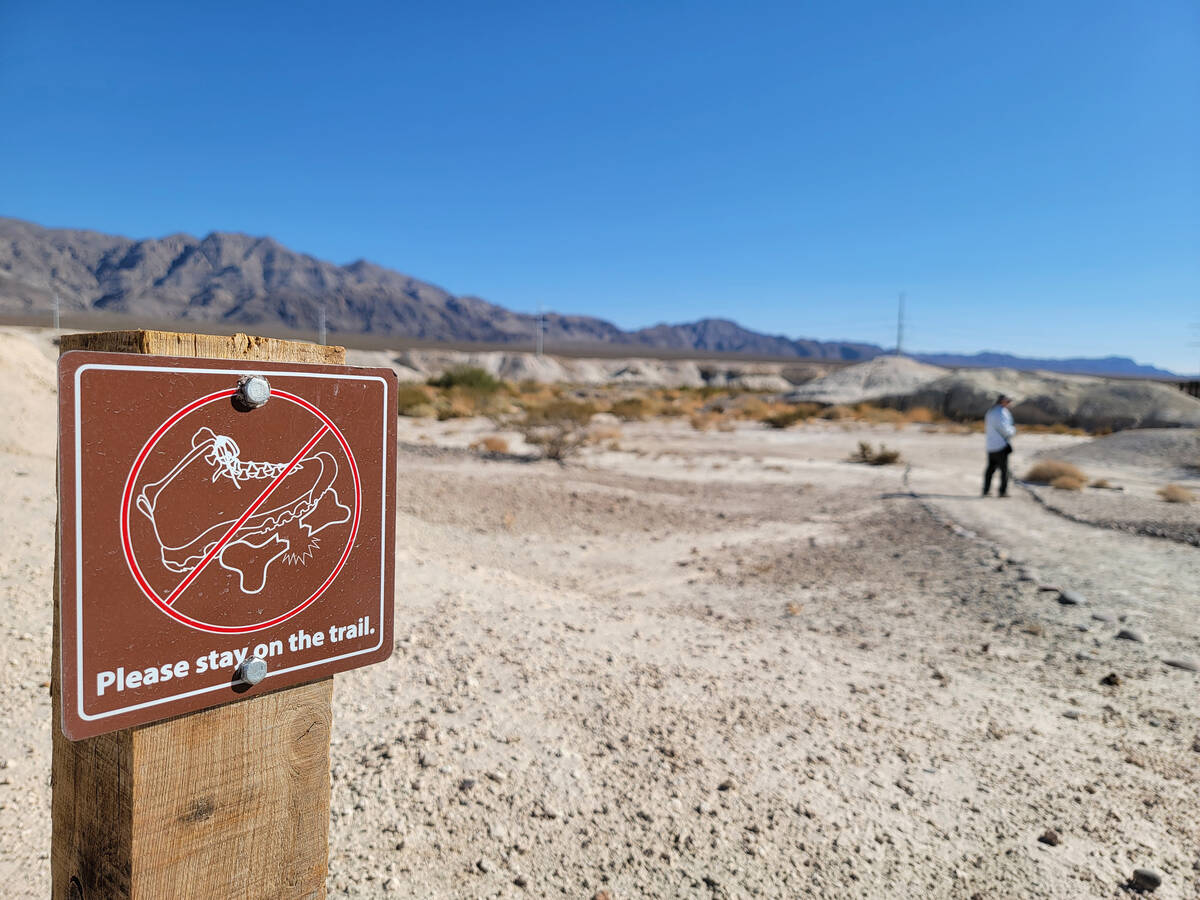On the trail of extinct creatures at a Southern Nevada state park
Mammoths, dire wolves and saber-toothed cats. Oh my, what a fascinating walk through Pleistocene history is provided by a relatively new Southern Nevada state park.
Ice Age Fossils State Park opened almost a year ago in the far northern reaches of the Las Vegas Valley. The 315-acre park includes about 3½ miles of interconnecting, mostly flat, hard-packed dirt trails. Visitors are expected to stay on the official paths at a site where fossil protection is a top priority.
Walking on the designated trails — Big Dig, Las Vegas Wash and Megafauna — comes with a healthy educational dose of natural history. Life-sized metallic Ice Age animal profiles and accompanying interpretive panels are found on the short Megafauna trail. Fossils exist and might be within sight along the rock-lined 1.5-mile Las Vegas Wash trail. A walk through a trench carved out decades ago to conduct research exposes more proof of Pleistocene life on the 1.2-mile Big Dig trail.
Still, the overall beige starkness of the setting initially makes it a bit of a struggle to suspend reality and imagine the lush and verdant landscape of 20,000 years ago, when Columbian mammoths, giant-sized camels and American lions roamed Tule Springs. But impressive museum exhibits and a short film inside the visitor center tell that tale, and fossils continue to be uncovered regularly on-site and at neighboring Tule Springs Fossil Beds National Monument.
At the park’s entrance, the giant and whimsical Monumental Mammoth sculpture welcomes explorers to the visitor center and parking lot, 8660 N. Decatur Blvd., near the base of the towering Las Vegas and Sheep mountain ranges. Current park hours are from 8 a.m. to 4:30 p.m. Wednesdays through Sundays. The entrance fee is $3.
Hiking options
Depending on personal preferences, visitors can start with a park overview based on informative exhibits and a short film inside the center. If walking is the more immediate goal, there are two options for covering 3½ miles of trail. Visitors can take to the path right away and initially walk along the Megafauna trail and then connect to the Big Dig trail before merging onto the Las Vegas Wash trail and heading back toward the visitor center.
Or walkers can start at the Monumental Mammoth, follow signs to the Las Vegas Wash trail, merge onto the Big Dig trail and explore the Megafauna trail on their return to the visitor center. There are a few mild ascents and descents as well as some stairs, if covering 3½ miles, whichever direction walkers choose.
Visitors can shorten the distances by getting on just the Las Vegas Wash trail or connecting with the Big Dig trail from the visitor center. The Megafauna trail is less than a half-mile long and has the easiest accessibility because of its proximity to the visitor center.
This fall at Ice Age Fossils State Park, I picked the clockwise direction to cover 3½ miles, which meant starting at the 14-foot-tall Monumental Mammoth. That creative metal sculpture had its debut at the 2019 Burning Man festival in Northern Nevada. It’s worth taking time to notice the sculpture’s shiny prehistoric details — ancient shells, fossilized plants, a winged insect (with a visiting northern mockingbird perched beside it that morning).
From there, a path led to the Las Vegas Wash trail, which winds along creosote-dotted desert floor before crossing the Upper Las Vegas Wash, which is dry most days of the year. Vegetation is thicker in the wash because of the rains that arrive infrequently during storms and flash flooding.
Say’s phoebes, verdins and Anna’s hummingbirds may be seen as they continue foraging in the area during fall and winter, but colder temperatures typically force lizards and snakes into an inactive state called brumation.
Pleistocene secrets exposed
After crossing to a north bank of the Las Vegas Wash, trailgoers will find a fence blocking access to tall walls where fossils are exposed but difficult to distinguish with an untrained eye. With binoculars, one seashell was easily visible to me.
Informational panels describe the area’s geology and scientific significance, and the trail continues along the wash’s cliffs and ravines. Modern-day rainwaters passing through the Upper Las Vegas Wash and general Tule Springs area help expose more secrets about the lives of long-extinct creatures and their environment.
Megafauna roamed the Las Vegas Valley from 100,000 to 12,500 years ago. The climate was hospitable enough to support herds of mammoths, camels and bison, along with their predators, such as American lions, saber-toothed cats and dire wolves. Flowing water, marshes and wet meadows supported plant life needed by hungry Ice Age herbivores.
Visitors on the Las Vegas Wash trail nowadays are passing through formerly lush and verdant areas, even though it’s hard to imagine that landscape when walking on a dusty trail without much flora or fauna.
Before long, a trail junction allows Las Vegas Wash walkers to head in the direction of the Big Dig trail, named after the multidisciplinary pursuit that put Southern Nevada on the paleontology map.
In the early 1960s, the scientific question was whether humans might have lived in the Las Vegas Valley at the same time as megafauna. Ice Age camel bones had been found in the vicinity of what looked like human campfire remnants. Scientists used advanced lab techniques, and bulldozers carved out enormous trenches to race toward the answer.
That answer turned out to be “no,” but in the process scientists and field workers unearthed thousands of fossils of Ice Age animals. They also exposed rock layers that continue to be studied today.
On the Big Dig trail, visitors can step onto a platform that covers a historic area where a large concentration of Ice Age fossils was discovered. They can also walk through a “Big Dig” trench cut out 60 years ago that helped turn Southern Nevada into the home of the largest collection of Pleistocene fossils in the Southwest.
Some of those fossils are on display at the visitor center, and many other remnants of extinct creatures are still hidden under layers of what’s now the Mojave Desert.
If you go
Pleasant days in fall and winter are ideal for exploring Ice Age Fossils State Park, but conditions would be miserable on hot days from late spring to early fall because of constant sun exposure on the trails. More information about the park and its programming is available at parks.nv.gov/parks/ice-age-fossils.



























